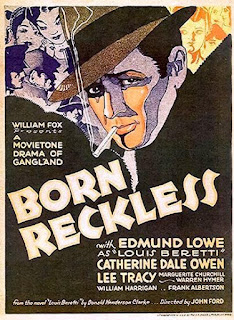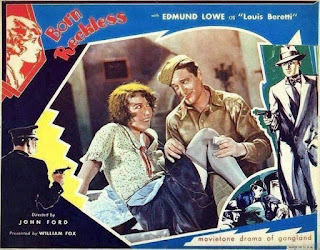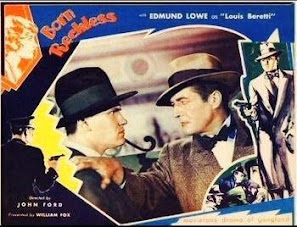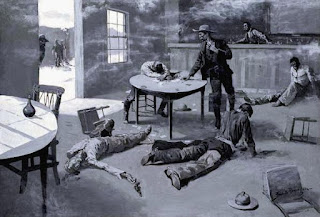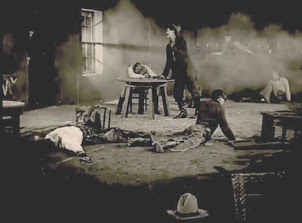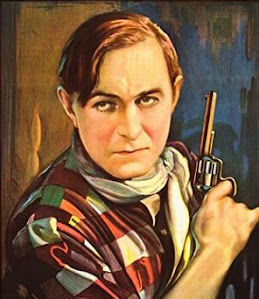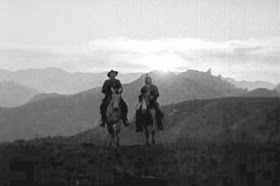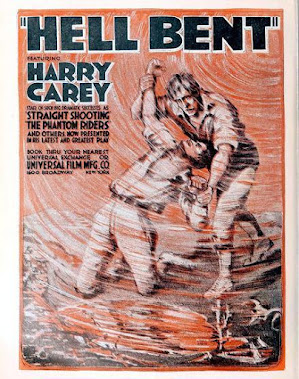
 |
| The Secret Spring - musician |
The arrival of a nice tinted copy of Léonce Perret’s three hour 1923 Koenigsmark / The Secret Spring on La Cinémathèque Française’s Henri streaming site fired up my deja vus. It brought back the nineteen fifties week end when I threaded that dupey 16mm. of the silent Jaques Feyder L’atalantide on ABC TVs new Steenbeck editing table, the copy the Federation of Film Archives stiffed the National Library with, to sustain the illusion that they were looking after them and get them to subscribe. The Sunday shift gathered round, intrigued by an already decades old movie.
I remember thinking that was a testimony to vintage popular film. These were people who would have ignored Un chien Andalou.
Koenigsmark and L’atalantide are both derived from novels by Academie Française member Pierre Benoît. He and his work inhabit a long past era. Rider Hagard once sued him for copyright infringement over the resemblances between “She” and “L’atalantide.” You could make a case for the Benoît plots as accounts of women in power, currently topical, but watching the The Secret Spring did seem like a chore, mandated to fill in that gap in knowledge of French film between Louis Feuillade and René Clair. However, as sixty years ago, I found myself sucked in.
 |
| Koenigsmark 1923 / The Secret Spring: Huguette Duflos, Marcya Capri in decor. |
There are a couple more later adaptations, one by Solange Térac with Silvana Pampanini in 1953 and a TV film by Jean Kerchbron in 1968.
Now forgotten, Catelain was a recurring face in twenties French melodramas and, here younger, he is a more convincing focus for our sympathies - though those plucked eye brows are still a bit much.
 |
| Secret Spring - Duflos |
Duflos’ glamor is more plausible as she displays the transition from the earlier decades’ ugly high fashion to the more presentable styles found in the French haute couture film cycle then beginning. She even has a miroir à trois faces.
Catelain’s midnight investigation of the “Hall of Armor” unearths the secret of Koenigsmark, complete with safe cracking and false identities. The bad hats resolve to burn down the East Wing of the Castle to cover their misdeeds, while a duel has Iván Petrovich, lead of Michael Curtiz silents, facing Catelain with pistols at dawn until Hugette reminds him that she bought Petrovich's honor as an officer along with his gambling debts.
There’s still space for an eve of WW1 nocturnal flight in the white “Torpedo” car, flourishing dodgey safe conducts to border guards and a climax at the Arc de Triomphe - or not - depending on whether you get the happy end. These flamboyant plot complications work better here than in the sound films.
First off is the fact that Secret Spring, not unlike the Twentieth Century B westerns, is set in that curious period where mounted cavalry occupy the same world as electric light, telephones and automobiles. A more appropriate comparison is with the long lived costume melodrama esthetic of MGM efforts like "The Prisoner of Zenda" and "The Merry Widow", with which the French film more than holds its own. Performances are uniformly well judged.
 |
| Secret Spring - Duflos with toned feux d'artifice. |
Until Pordenone mounted a season of his early work with muse Susanne Grandais, I knew Perret’s name only from obscure literature - an actor in Feuillade movies and a two reel comic, though there actually prove to be a couple of pages of his clips and shorts on You Tube. His touch, when a seasoned director, remains sure, after all this time.
Secret Spring -The wonder of 35mm. home movies - Capri & Duflos.
A hundred year old, three hour movie with untranslated French language captions is not for everyone but, to a motivated viewer, it is one of the best ways to be transported back into the idiom of its film making and the mind set of it’s day. I’m delighted to find I can still enjoy that.
 |
| Jaque Catelain in Le vertige. |
Barrie Pattison - 2023


